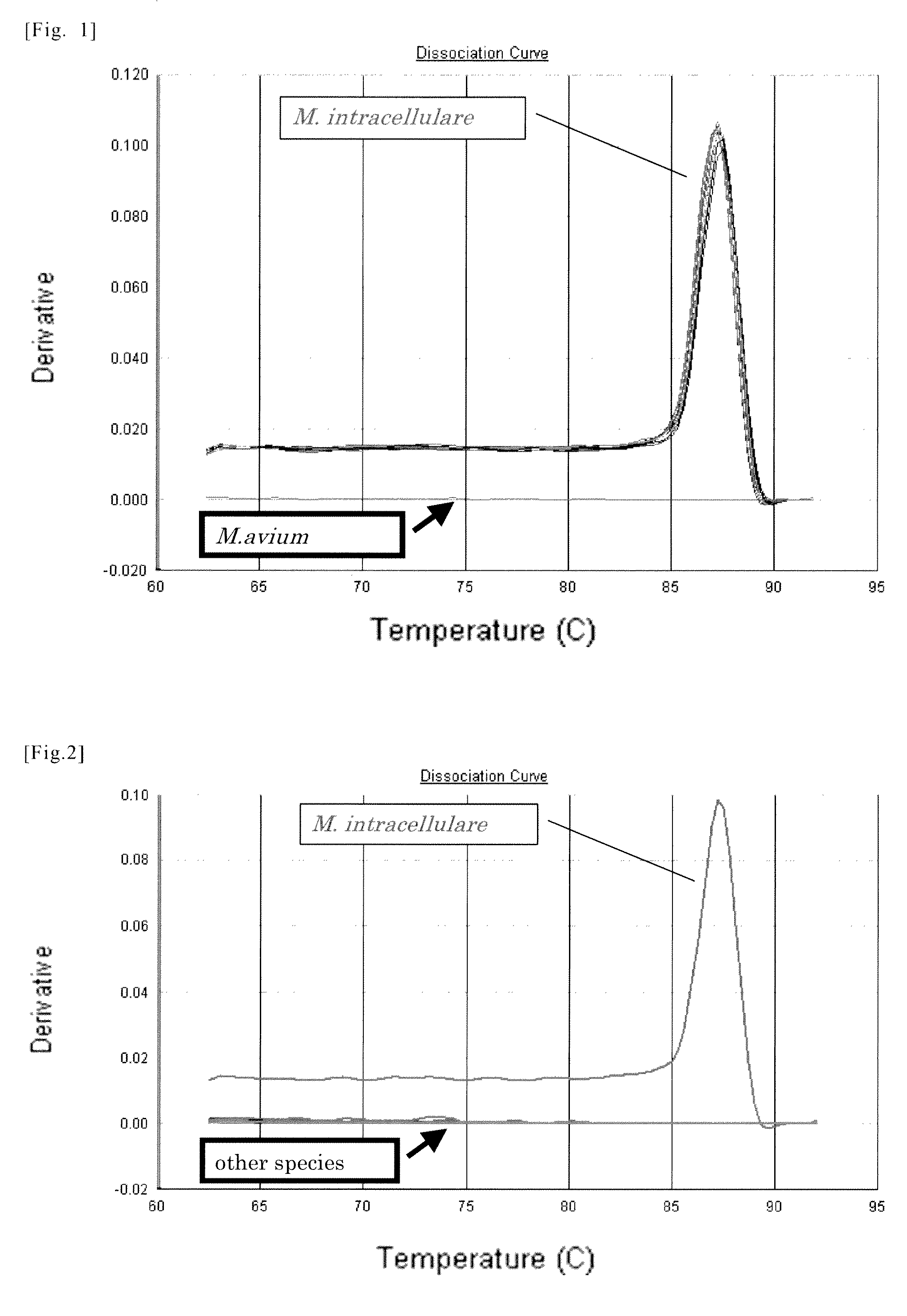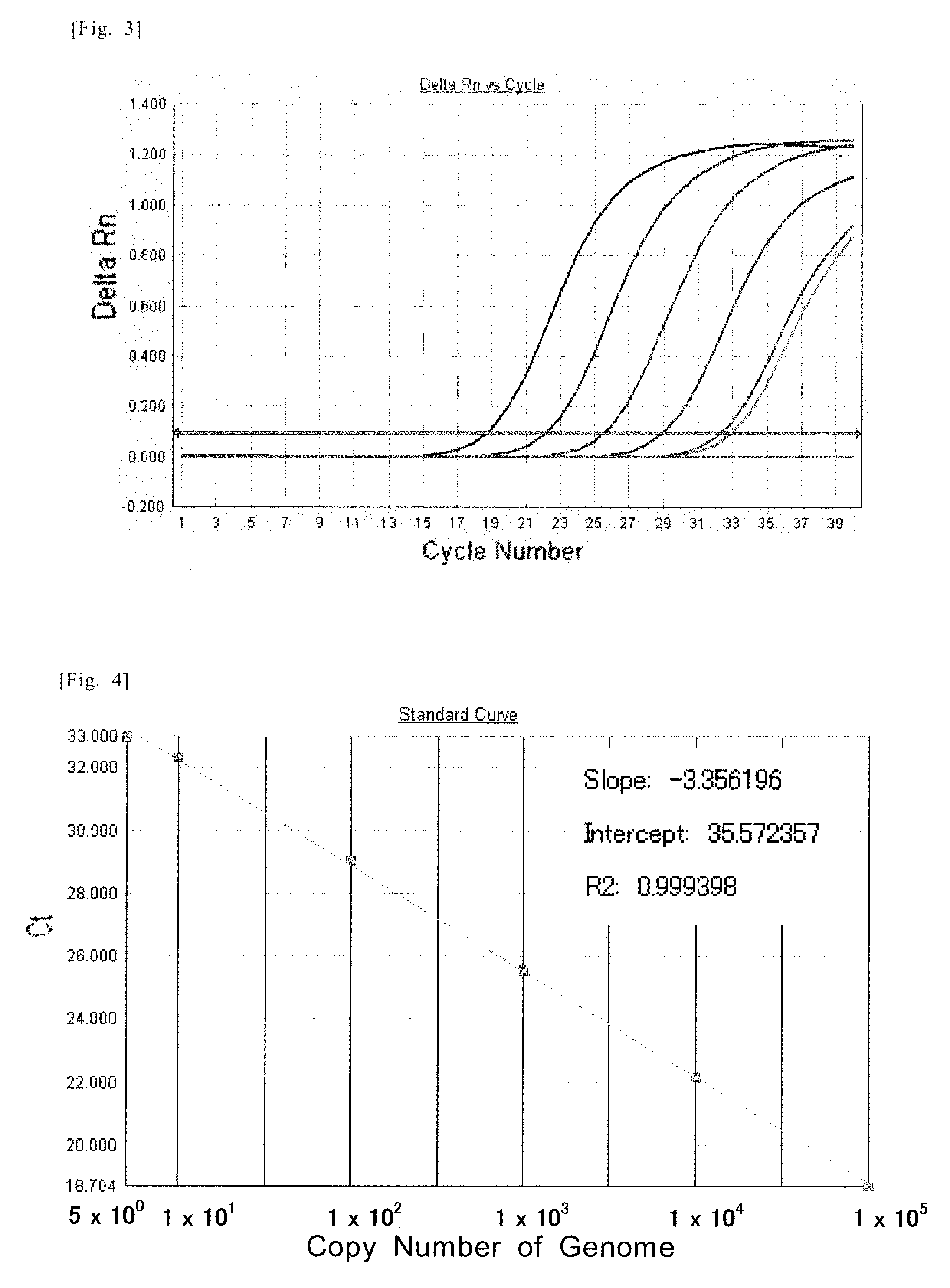Primer and probe for detection of mycobacterium intracellulare, and method for detection of mycobacterium intracellulare using the primer or the probe
a technology of mycobacterium and probe, which is applied in the direction of liquid/fluent solid measurement, fluid pressure measurement, peptide, etc., can solve the problems of difficult to differentiate tuberculosis from nontuberculous mycobacterial disease, no specific clinical symptoms of nontuberculous mycobacterial disease, and exert infectivity to human beings, etc., to achieve detection and diagnosis more quickly, high accuracy, high accuracy and precision
- Summary
- Abstract
- Description
- Claims
- Application Information
AI Technical Summary
Benefits of technology
Problems solved by technology
Method used
Image
Examples
example
Example 1
Selection of a Clone Derived from M. intracellulare
[0380](1) Preparation of DNA Sample Derived from M. intracellulare
[0381]Firstly, Mycobacterium intracellulare JCM6384 (donated from Institute of Physical and Chemical Research), a type strain of M. intracellulare, was suspended in purified water and autoclaved (at 120° C., 2 atmospheres for 20 minutes). Subsequently, after the bacterial cell was subjected to disruption treatment (physical disruption using 2 mm diameter glass beads), the suspension was centrifuged, and thus a supernatant solution was obtained. From the supernatant solution obtained, extraction and purification of DNA was carried out using an ion-exchange resin type DNA extraction and purification kit, Genomic-tip, produced by Quiagen GmbH, and purified genomic DNA derived from M. intracellulare (Mycobacterium intracellulare JCM6384) was obtained.
[0382]The obtained purified genomic DNA derived from M. intracellulare was adjusted to give final concentration ...
example 2
Evaluation of Inter-Strain Conservation-1 in the Case where Candidate Sequence A in M. intracellulare
(1) Synthesis of the Primer of the Present Invention
[0437]Among the candidate clones listed in Table 6 which were determined in (9) of Example 1, based on the result of the sequence analysis (nucleotide sequence) of the candidates clone A (Clone ID NO: R02—5h), and from its candidate sequence A (SEQ ID NO: 1), the nucleotide sequence to be used for the PCR, namely, “5′-CGTGGTGTAGTAGTCAGCCAGA-3′” (SEQ ID NO: 16; hereinafter referred to as “Mint 02_T7pa Fw1”) and “5′-AAAAACGGATCAGAAGGAGAC-3′” (SEQ ID NO: 17; hereinafter referred to as “Mint 02_T7pa Rv1”) were designed using the Web tool Primer3 for primer design (produced by Whitehead Institute for Biomedical Research).
[0438]Next, using ABI 392 DNA synthesizer produced by ABI, the oligonucleotide with a designed nucleotide sequence was synthesized by phosphoramidite method. The synthetic procedure was in accordance with the manual sup...
example 3
Evaluation of Inter-Strain Conservation-2 in the Case Wherei Nucleotide Sequence of Other Candidate Clones Among M. intracellulare
[0454]Based on the result of analysis of each sequence (nucleotide sequence) of the candidates clone A to O which was determined in (9) of Example 1 and listed in Table 6, and from the nucleotide sequence of each candidate clone, primer sequence for the PCR amplification detection was designed respectively using the Web tool Primer3 for primer design (produced by Whitehead Institute for Biomedical Research).
[0455]The name of each candidate sequence, the SEQ ID NO of the nucleotide sequence of the candidate clone, the name of the primer designed based on the nucleotide sequence of the candidate clone (named by the present inventor) and the SEQ ID NO of the nucleotide sequence, and further, the combination of forward primer and reverse primer to be used for performing following PCR were shown collectively in Table 7.
TABLE 7Candidate cloneDesigned primerSEQ...
PUM
| Property | Measurement | Unit |
|---|---|---|
| time | aaaaa | aaaaa |
| temperature | aaaaa | aaaaa |
| pressure | aaaaa | aaaaa |
Abstract
Description
Claims
Application Information
 Login to View More
Login to View More - R&D
- Intellectual Property
- Life Sciences
- Materials
- Tech Scout
- Unparalleled Data Quality
- Higher Quality Content
- 60% Fewer Hallucinations
Browse by: Latest US Patents, China's latest patents, Technical Efficacy Thesaurus, Application Domain, Technology Topic, Popular Technical Reports.
© 2025 PatSnap. All rights reserved.Legal|Privacy policy|Modern Slavery Act Transparency Statement|Sitemap|About US| Contact US: help@patsnap.com


